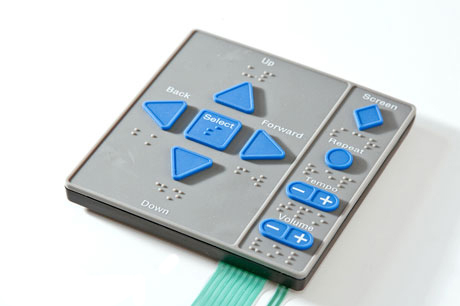Discover How Membrane Switches Feature and Their Duty in Modern Electronics
Membrane Switches stand for an innovative combination of modern technology and layout within the realm of modern electronic devices, offering as crucial interfaces in countless devices. Comprehending the ins and outs of Membrane switch capability and their broader ramifications in boosting user experience invites more expedition into their style, benefits, and the cutting-edge developments shaping their future in innovation.
What Are Membrane Buttons?

Membrane switches are differentiated by their longevity and resistance to environmental factors, such as dust, moisture, and extreme temperatures. They can be tailored with numerous graphics, shades, and tactile feedback options, enhancing user experience while maintaining aesthetic appeal - membrane switches. The consolidation of printed circuits enables for seamless integration right into tools, enhancing general performance.
The flexibility of Membrane buttons is noticeable in their capacity to support both easy and complex control features. They can integrate features such as LED indicators and touch-sensitive modern technology, accommodating particular user needs. As modern technology continues to evolve, Membrane Switches remain essential for making it possible for user-friendly and efficient user interfaces, thereby playing a crucial function in the development of modern-day electronic gadgets.
Parts of Membrane Buttons
Membrane switches are composed of a number of key parts that work with each other to produce a reputable and functional user interface. The primary aspects include the visuals overlay, glue layer, spacer layer, and conductive traces.
The graphic overlay functions as the individual interface, typically published on a flexible substrate such as polyester or polycarbonate. This layer not just gives visual appeal however additionally includes tactile responses, visual hints, and safety features. Underneath the graphic overlay lies the sticky layer, which safeguards the switch to the gadget and makes certain toughness versus environmental anxieties.
The spacer layer is critical for maintaining the needed void in between the graphic overlay and the circuit layer. When pressure is applied, this space permits for the activation of the button. The conductive traces, usually made from silver or carbon, develop the electrical paths that finish the circuit when the button is involved.
Additionally, a backing layer may be included for architectural assistance and insulation. These elements collaborate seamlessly, guaranteeing that Membrane buttons are both user-friendly and durable, making them indispensable in various contemporary digital applications.
How Membrane Switches Job
Just how do Membrane Switches function effectively within digital tools? Membrane Switches operate the concepts of pressure-sensitive modern technology, using a layered building that includes visuals overlays, glue layers, and conductive aspects. When an individual applies stress to the button, the top layer deforms, permitting the conductive aspects below to make contact and finish an electric circuit. This action triggers the wanted function within the device.
The design of Membrane switches is crucial for their reliable operation (membrane switches). The layers are diligently crafted to provide responsive comments, durability, and resistance to ecological elements such as dampness and dust. The inclusion of domes-- small, elevated areas within the switch-- improves responsive feedback, offering individuals with a noticeable click feeling upon activation
Moreover, Membrane buttons can be personalized in regards to size, form, and graphics, making them ideal for various applications. They are typically used in control panels, medical tools, and consumer electronics as a result of their sleek style and integrity. In general, the reliable performance of Membrane switches is crucial in enhancing individual communication and guaranteeing smooth procedure in modern electronic gadgets.

Applications in Modern Devices
Utilizing their special layout best site and capability, Membrane buttons have actually become essential elements in a wide variety of modern-day digital tools. These functional user interfaces are used in customer electronic devices, commercial tools, clinical tools, and auto controls, giving smooth customer communication.
In customer electronic devices, Membrane switches are typically discovered in home appliances like microwaves, washing devices, and other household devices, where they enable instinctive control with a streamlined profile. Their low-profile layout facilitates integration into portable tools, boosting aesthetic appeal without compromising functionality.
In commercial applications, Membrane Switches offer as control board for equipment, providing sturdiness and resistance to harsh settings. Their capability to endure moisture and impurities makes them excellent for usage in manufacturing and handling markets.
Medical tools likewise gain from Membrane switches, which are designed to be very easy to clean and maintain, making certain hygiene in clinical setups. They are typically used in analysis devices, client monitoring systems, and mobile medical gadgets, where reliability is extremely important.
Advantages of Membrane Switches
One of the crucial benefits of Membrane buttons is their flexibility, which permits them to be tailored for a selection of applications across numerous markets. These buttons can be developed in numerous shapes and dimensions, accommodating one-of-a-kind product demands while providing smooth integration right into devices. Their thin try this out account enables a smooth and compact design, commonly enhancing the aesthetic appeal of electronic products.
Another considerable advantage is their durability - membrane switches. Membrane switches are normally immune to dust, wetness, and chemicals, making them excellent for harsh atmospheres. This strength extends their life expectancy contrasted to traditional mechanical switches, minimizing the demand for frequent replacements
Furthermore, Membrane Switches deal cost-effectiveness. The manufacturing process involves printing innovations that decrease manufacturing costs, particularly for big runs. This cost, incorporated with reduced upkeep requirements, makes them an attractive option for makers.

Conclusion
Finally, Membrane Switches represent a considerable innovation in interface technology within modern electronics. Their layered construction, pressure-sensitive operation, and adaptability to numerous applications underscore their importance across numerous sectors. The longevity and ecological resistance of Membrane Switches additionally boost their charm, making them a favored option for makers seeking reputable and adjustable services. As the demand for user-friendly and resilient interfaces continues to grow, the duty of Membrane switches in shaping customer experience will most certainly increase.
Membrane Switches stand for a sophisticated assimilation of innovation and design within the world of modern electronic devices, serving as necessary interfaces in countless gadgets.In the world of contemporary electronic devices, Membrane Switches offer as important components that assist in user communication with devices. As innovation proceeds to develop, Membrane Switches stay essential for allowing instinctive and effective individual interfaces, therefore playing a critical function in the innovation of modern-day digital tools.
How do Membrane Switches function efficiently within electronic gadgets? Overall, the effective performance of Membrane switches is critical in improving individual communication and making certain smooth operation in contemporary electronic devices.